
The term “slot” is an acronym for “slave of technology”. It’s a grammatical term that describes someone who cannot live without their electronic gadgets. The term applies to a number of urban teenagers, and is used both for guys and girls. There’s even a slot for the chief copy editor. The term comes from German, where the word “slot” is cognate with the word “schloss.”
The payback percentage is a key statistic that makes it possible to calculate how much a particular slot machine will pay out to its player. Assuming there’s a dozen different pay tables, the probability of each winning combination would be zero except for the largest payout, which would be 4,000 times the input amount. Such a situation would make the game very boring and most people wouldn’t win anything. In addition, entries with a return of zero would be deceptive.
While video slots have similar operating principles to standard slot machines, they use a video image instead of spinning reels. When video slots first appeared, players were skeptical of them. Because the reels were not spinning, players didn’t feel in control of the outcome. However, manufacturers have incorporated handles and reels into video slots to create the illusion that the player is in control of the game. Despite this, these features do not have any effect on the outcome.
The expansion slot, on the other hand, is an engineered way to expand the capability of a computer. These slots have multiple rows of closely-spaced pinholes that can be used to install additional hardware. These expansion slots are found on almost every desktop computer. As such, the majority of new computers have this option. While it might be difficult to change processors, it allows computers to adapt to new hardware. If the need arises, it’s best to consider upgrading to a new hardware.